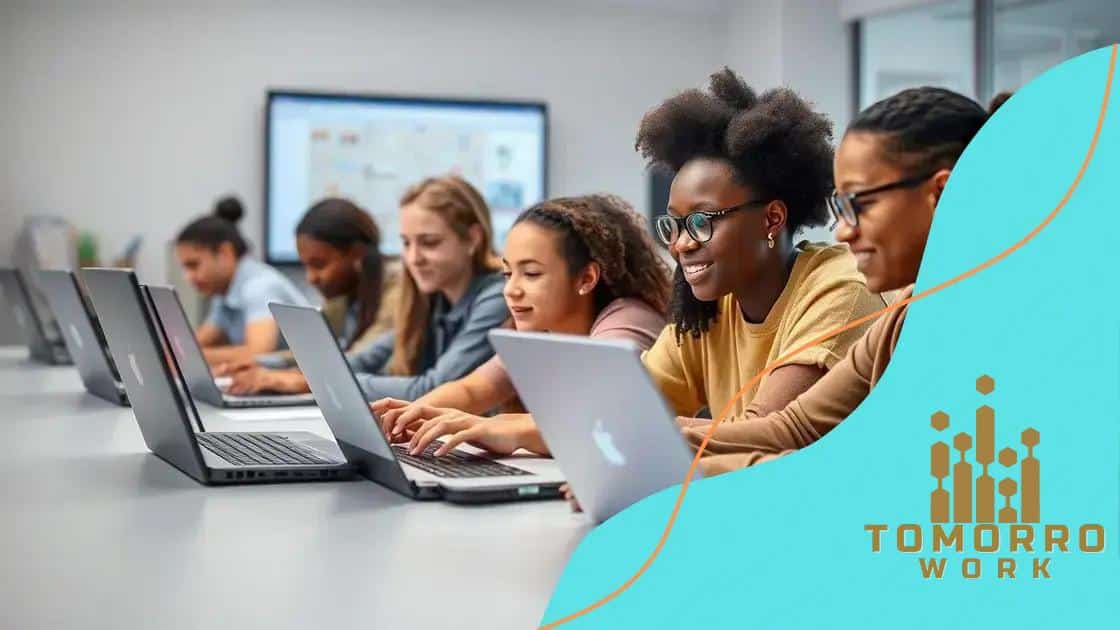The impact of virtual classrooms on student collaboration

Advertisements
The impact of virtual classrooms on student collaboration enhances teamwork through interactive tools, flexible learning environments, and improved communication, despite challenges like technical issues and engagement.
The impact of virtual classrooms on student collaboration is transforming how students work together. Have you ever wondered how these environments foster teamwork? In this article, we’ll explore their significance and benefits.
Advertisements
Understanding virtual classrooms
Understanding virtual classrooms is essential as education increasingly moves online. These environments allow students to learn and collaborate from anywhere. But what does it really mean to be in a virtual classroom?
What Are Virtual Classrooms?
Virtual classrooms are online learning spaces where instructors and students interact. They use technology to bridge physical distances. You might think of them as digital versions of traditional classrooms.
Many features define virtual classrooms, including:
Advertisements
- Real-time communication: Students and teachers can chat or video call instantly.
- Interactive learning tools: Whiteboards, quizzes, and polls engage students.
- Accessible resources: Course materials are often available online at any time.
- Flexible scheduling: Students can attend classes from anywhere with internet access.
Benefits of Virtual Learning
There are numerous benefits to learning in a virtual classroom. First and foremost, it increases accessibility for students who may not be able to attend physical schools. They can learn from the comfort of their homes, making education more inclusive.
Moreover, these platforms often allow for a more personalized learning experience. Students can set their own pace and revisit materials as needed. Interaction with peers and instructors happens through discussion boards, improving engagement.
Class participation can also be heightened. Some students feel more comfortable sharing their thoughts online than in-person. This creates a more dynamic classroom where ideas flow freely.
In summary, virtual classrooms are changing the educational landscape by offering new opportunities for collaboration and learning.
Key benefits of virtual collaboration
The key benefits of virtual collaboration are reshaping how students interact and work together in online settings. Many students find these environments more engaging and productive.
Enhancing Communication
One major advantage is improved communication. Virtual platforms enable quick exchanges of ideas. Through chat features and video calls, participants can share thoughts instantly, breaking down geographical barriers.
Additionally, virtual collaboration enhances group dynamics. Students learn to work as a team while using digital tools. This helps them build essential skills for future careers.
Flexibility and Accessibility
Virtual collaboration provides flexibility that traditional settings cannot match. Students can join discussions from any location. This flexibility leads to increased participation.
It also allows access to diverse perspectives. Students from various backgrounds can contribute their views, enriching discussions and boosting cultural understanding.
- Increased participation: More students may feel empowered to speak up in a virtual setting.
- Diverse perspectives: Online collaboration brings together unique viewpoints that enhance learning.
- Comfortable environment: Many students feel more at ease sharing their ideas through a screen.
Moreover, virtual collaboration supports the development of digital skills. These skills are vital in today’s job market. As students work on projects online, they become proficient with various tools and technologies.
Ultimately, the key benefits of virtual collaboration extend beyond academic success. They prepare students for their future careers by offering essential skills and experiences.
Tools for effective online teamwork

Using the right tools for effective online teamwork can make a big difference in virtual classrooms. These tools help streamline communication and collaboration among students. Let’s explore some of the best tools available.
Communication Platforms
Platforms like Zoom and Microsoft Teams allow real-time communication. These tools support video calls and chats, making it easy for students to discuss projects together.
In addition to video platforms, messaging apps such as Slack and Discord offer instant messaging capabilities. These platforms help maintain open lines of communication without the need for video.
Collaboration Tools
When it comes to working on projects, tools like Google Docs and Trello are essential. These applications allow multiple users to contribute and edit documents simultaneously.
- Google Docs: Perfect for writing and sharing documents in real-time.
- Trello: Ideal for project management with boards and cards to track progress.
- Asana: Helps teams organize tasks and deadlines effectively.
Another useful tool is Miro, which provides a virtual whiteboard for brainstorming sessions. Students can visually collaborate and share ideas, enhancing creativity.
Utilizing these tools effectively can help enhance student engagement and productivity in virtual classrooms. By integrating various platforms, students can communicate and collaborate more efficiently. These technologies prepare students for the workforce by fostering digital collaboration skills.
Challenges in a virtual classroom setting
Challenges in a virtual classroom setting can impact student learning and engagement. Although online learning offers many benefits, it also presents unique obstacles that educators and students need to address.
Technical Issues
One major challenge is technical issues. Students may experience poor internet connections or software glitches. These problems can disrupt lessons and lead to frustration.
Additionally, not all students have access to reliable devices. This digital divide can create inequalities in participation and learning opportunities. Educators must find solutions to ensure all students can participate effectively.
Engagement and Motivation
Another challenge is keeping students engaged and motivated. In a traditional classroom, teachers can gauge student interest through body language and feedback. In a virtual classroom, this becomes more difficult.
- Distractions at home: Students may struggle to concentrate due to distractions in their home environment.
- Lack of interaction: Limited face-to-face interaction can make collaborative activities feel less personal.
- Self-discipline: Students need to have strong self-discipline to stay focused on their studies.
Moreover, providing personalized support becomes challenging in a virtual setting. Teachers might find it hard to identify students who need extra help. This can lead to some students feeling lost or disconnected from the material.
Lastly, building a sense of community is crucial but often difficult in virtual classrooms. Creating connections among students and between students and teachers is essential for a positive learning experience. Educators need to be proactive in fostering these relationships to ensure students feel supported.
Strategies to enhance student interaction
Strategies to enhance student interaction in virtual classrooms are essential for keeping learners engaged and motivated. Increasing interaction helps build a sense of community while improving learning outcomes.
Use of Interactive Tools
One effective strategy is to incorporate interactive tools. Platforms like Padlet and Kahoot! allow students to participate in quizzes and discussions. These tools make learning fun and engaging.
Furthermore, using virtual breakout rooms can promote small group discussions. This encourages students to share their thoughts in a less intimidating environment, leading to deeper conversations.
Encouraging Participation
Teachers can actively encourage participation by asking open-ended questions. This invites all students to contribute their ideas. Polling and feedback tools can also be used to involve students in decision-making processes about their learning.
- Utilize icebreakers: Start the class with fun icebreakers to help students feel comfortable.
- Implement collaborative projects: Encourage teamwork by assigning group projects that require collaboration.
- Incorporate discussions: Schedule regular discussion sessions to allow students to share their insights on various topics.
Moreover, integrating social media platforms can also enhance interaction. Creating private groups on sites like Facebook or Twitter provides students with informal spaces to communicate and collaborate outside of formal learning settings.
Setting clear expectations for participation is crucial. Letting students know they are expected to engage creates a more dynamic learning environment. When students feel they play an active role, they are more likely to stay engaged.
FAQ – Frequently Asked Questions about Virtual Classrooms
What are the main benefits of virtual classrooms?
Virtual classrooms enhance collaboration, provide flexible learning opportunities, and increase accessibility for students in different locations.
How can teachers engage students in a virtual setting?
Teachers can engage students by using interactive tools, asking open-ended questions, and encouraging participation through group discussions.
What tools are effective for online teamwork?
Effective tools include Zoom for communication, Google Docs for collaboration, and Trello for task management.
What challenges do students face in virtual classrooms?
Students may encounter technical issues, distractions at home, and difficulties with motivation and participation compared to traditional classrooms.





